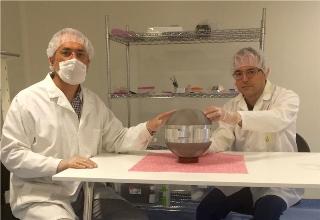Nov 3 2015
In the framework of the European Space Agency’s Exomars Robotic Exploration Mission to explore the planet Mars, EMXYS as a leader of a Spanish consortium that includes the Universitat Politècnica de València, GMV and AURORASAT, has presented its conclusions to the European Space Agency (ESA) for the implementation of the Long Range Radio Frequency Navigation Sensor planned to be on-board the Mars spacecraft intended to get back to Earth 500 grams of Martian rocks and sand.
 OS capsule in clean room
OS capsule in clean room
ESA’s Mars Sample Return Mission pretends to retrieve half a kilogram of Mars soil material by landing a spacecraft on its surface that will load it into a 23cm sphere which will subsequently be sent into orbit around the planet. This sphere will be captured by a bigger spacecraft that will then travel back to Earth with the Mars samples. In order to find the football size sphere by the returning spacecraft, and manage the rendezvous and capturing manoeuvres, a set of sensors come into play being the developed Long Range Radio Frequency Navigation Sensor the first one able to detect the sphere from a distance of 3000 Km.
The activity has included a simulation study of the rendezvous and docking scenario orbiting around the planet Mars that permitted to derive the desired requirements for the sensor, which includes an UHF antenna and radiofrequency transmission and reception electronics as well as data processing. The antenna has been designed by AURORASAT in cooperation with the Electromagnetic Radiation Group (GAM) of the UPV Institute of Telecommunications and Multimedia Applications (iTEAM), and consists of four PIFA elements made out of metallic elements with no dielectric materials that fit in the equatorial plane of the 23cm sample container sphere. EMXYS has implemented the electronics and conditioning on board hardware including the generation and processing of UHF carriers by using a FPGA. Last, GMV has completed a simulation study of the rendezvous and docking scenario to derive the requirements for the sensor and finally has verified that the obtained performances of the breadboard meet the required specifications.
The European Space Agency (ESA) is an international organisation with 22 Member States. By coordinating the financial and intellectual resources of its members, it can undertake programmes and activities far beyond the scope of any single European country. ESA’ Mars Sample Return Mission is key to understanding the Red Planet. Bringing samples of Mars back to Earth, although technologically challenging, is essential for answering critical scientific questions that cannot be addressed by purely in situ missions.
EMXYS is an innovative company that under AS9100 quality standards designs develops and produces embedded instruments, data acquisition and control systems for industrial and scientific Space applications.
Aurora Software and testing, S.L., AURORASAT, is a technology-based SME established in the UPV Polytechnic City of Innovation (CPI) Scientific Park whose main business line is the development of CAE tools for the analysis, synthesis and design of passive RF components and antennas for telecommunications systems.
GMV is a privately owned technological business group with an international presence. Founded in 1984, GMV offers its solutions, services and products in very diverse sectors: Aeronautics, Banking and Finances, Space, Defense, Health, Security, Transportation, Telecommunications, and Information Technology for Public Administration and large corporations.